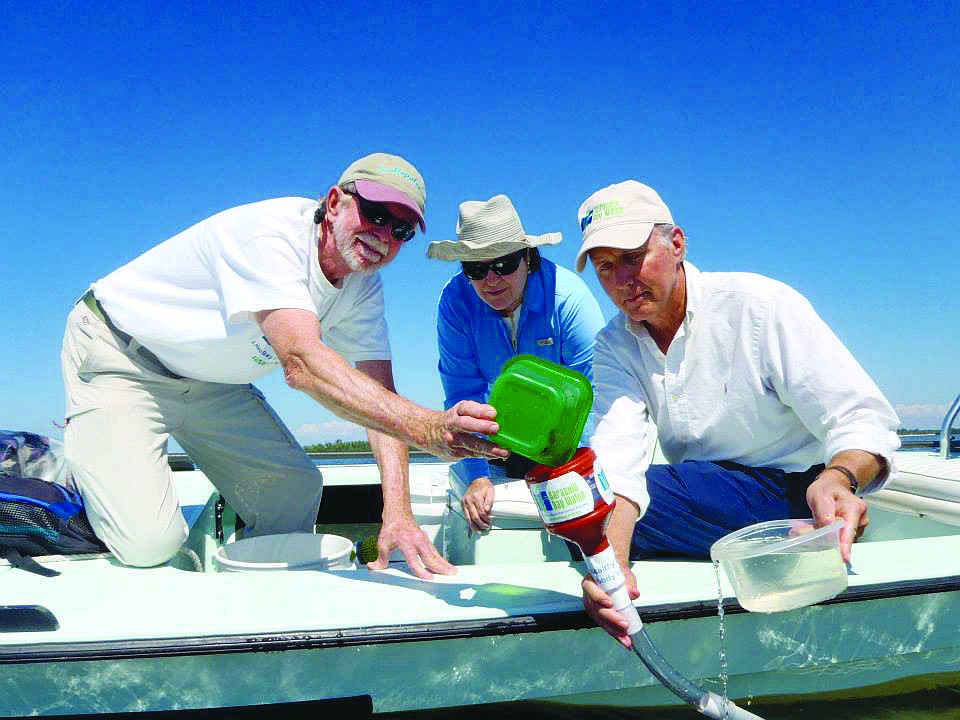- July 26, 2024
-
-
Loading

Loading

Scallops are tasty.
We humans know it. And so do a wide array of marine life, such as pinfish, crabs, rays and octopi — just a few of the mollusks’ natural predators.
Sarasota Bay Watch believes the latest batch of approximately 100,000 scallops it released Friday, Oct. 11, could be less vulnerable to predators.
That’s because the scallops are juveniles that are just more than 1 month old that have a developed shell and measure in at 2 to 3 millimeters. All of the 50 million scallops the group had deposited around Sarasota Bay since December 2011 as part of a 10-year restoration project were 10-day-old larvae that were a microscopic one-quarter millimeter.
Like all the scallops the group has released, the juveniles were raised at Curt Hemmel’s Bay Shellfish Co., in Terra Ceia. SBW volunteers carried them onto four boats and one paddleboard (to reach areas that are difficult to access by boat) in white buckets with battery-powered bubblers that circulate air.
Then, volunteers released small amounts of scallops at a time to avoid concentrating them in a single location, which could attract predators into shallow seagrasses that are a natural scallop habitat.
Sarasota Bay was home to a thriving scallop population until the 1960s.
“Due to construction, dredging and poor water quality, scallops have disappeared from the bay,” said Dr. Larry Stults, president of SBW. “Now that our water quality and seagrasses are healthy again, it’s time to have scallops back in the bay.”
Scalloping has been prohibited in Sarasota Bay since 1994, but SBW founder Rusty Chinnis believes there could be economic benefits if the population replenished to the point that scallop season could resume.
“Ultimately, people come from near and far to go scalloping in Steinhatchee, north of Crystal River,” Chinnis said.
But the benefit of a thriving population goes beyond the possibility of some day enjoying a meal of Sarasota Bay scallops.
“They’re really good for the bay because they’re a good food source,” Stults said. “When you have an additional food source at the bottom of the food chain, they help support fish and more diversity in wildlife.”
Scallops also help to clarify bay water because they eat algae and plankton. With clearer water, sunlight hits seagrass more directly, creating a “virtuous circle” according to Stults, because seagrass is a scallop habitat.
Juvenile scallops are more expensive to release than larvae. Growing 5 million to 10 million larvae costs approximately $10,000. Growing 50,000 to 150,000 juvenile scallops costs approximately $13,000 — and also requires more time and space.
The ongoing effort is funded solely by private donations and grants. SBW raises money for the effort, while Mote Marine Laboratory collects data.
SBW hasn’t determined how many scallops it will release this year. Seasonal conditions allow releases to continue through January, but the group currently only has enough funds to continue releases through October.
It’s too soon to know the impact of SBW’s efforts over the last two years.
“There isn’t much science around scallop restoration,” Stults said.
A successful restoration effort in Pine Island Sound, located near Sanibel Island, took approximately seven years to achieve. Red tide or an influx of rays or other predators could also deplete the population.
In the spring, officials from the Fish and Wildlife Research Institute will visit the area to collect data on the 100,000 scallops released Friday.
“The ultimate goal is to have a viable population of scallops in Sarasota Bay,” Chinnis said.
SCALLOP STATS
50 Million
The approximate number of scallop larvae Sarasota Bay Watch has released since December 2011.
100,000
The number of juvenile scallops the group released Friday, Oct. 11.
2-3 Millimeters
The size of a juvenile scallop.
1 Year
The lifespan of a scallop
Less than 1%
The likely survival rate of a scallop to maturity.
1/4 Millimeters
The size of a scallop larvae
Contact Robin Hartill at [email protected]